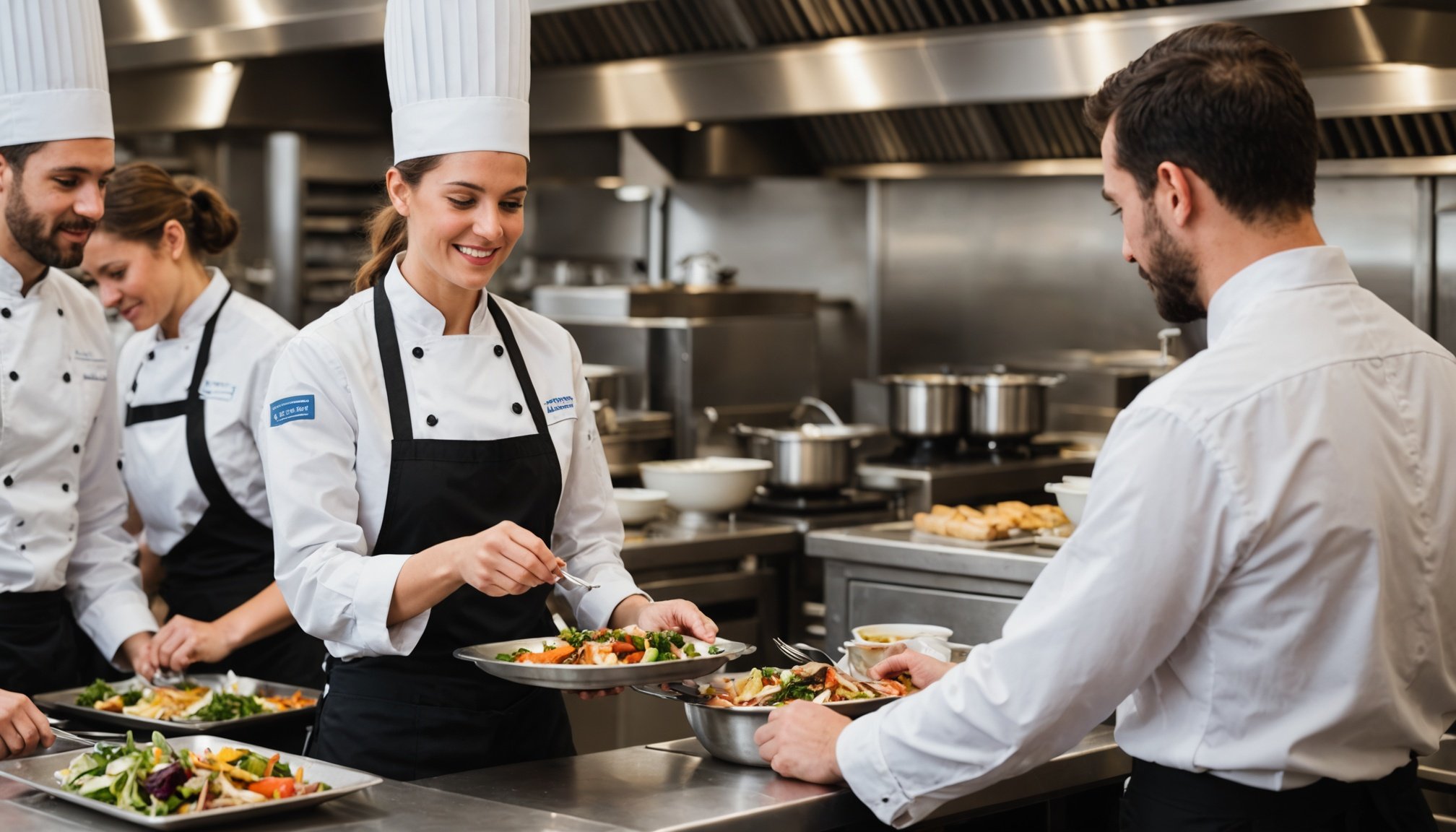Effective Training Techniques for Fast-Paced Environments
In the dynamic world of fast-paced restaurants, adopting innovative training methods is essential to maintain efficiency. These methods often include adaptive learning modules designed to accommodate various levels of staff expertise. This flexibility ensures that both novices and experienced employees remain engaged and capable during training sessions. Techniques such as real-time feedback and interactive digital platforms captivate staff, offering immersive learning experiences that traditional methods may lack.
To further enhance staff engagement, incorporating gamification elements can transform mundane tasks into challenges, boosting motivation. Additionally, role-plays and scenario-based exercises simulate real-life pressures, preparing staff for the high-stakes nature of restaurant environments. These experiences foster skill retention, as staff directly apply what they learn in training to real-world situations.
Also read : Mastering Pristine Draft Beer Lines: Expert Tips for Flawless Craft Brewery Maintenance
Adaptability remains crucial in training programs, as staff turnover and differing expertise levels demand a fluid approach. Trainers must constantly evaluate and tweak methods to ensure they remain relevant and effective. By doing so, restaurants can cultivate a resilient and highly skilled team capable of performing under pressure while maintaining exceptional service standards.
Leveraging Technology in Staff Training
Incorporating training technology revolutionises how fast-paced restaurant environments prepare their staff. Mobile training apps offer flexible, on-the-go learning, ideal for employees needing to balance training with demanding shifts. These apps usually feature interactive modules and real-time analytics, allowing both staff and trainers to track progress efficiently.
Topic to read : Crafting Unforgettable Signature Cocktails: Pro Tips for an Exceptional Bar Menu
Simulation tools provide another layer of technological enhancement; they create realistic practice scenarios crucial for developing quick problem-solving skills. For instance, virtual platforms can simulate a busy dinner rush, enabling staff to practise order management and customer service in a controlled setting. This experiential learning helps in reducing errors and increases staff confidence on the job.
Integrating technology with traditional methods ensures a comprehensive training experience. While digital tools deliver immediacy and engagement, classic on-the-floor practice solidifies learning outcomes. Blending these approaches accommodates diverse learning styles across varying expertise levels, fostering an adaptable and competent workforce. Employing this mix not only upskills current employees but also attracts tech-savvy talents who value innovative workplace solutions.
Best Practices for Menu Training
In fast-paced restaurant settings, menu knowledge training is crucial to ensure that staff can perform optimally even under the highest pressure. Understanding the ins and outs of the menu allows staff to provide better customer service and manage orders efficiently. To foster effective training practices, restaurants should implement accelerated learning techniques that enhance menu retention, helping staff quickly familiarize themselves with new offerings.
Fast-paced menu adaptation strategies involve interactive methods such as taste tests, quizzes, and live demonstrations. These approaches engage employees actively, allowing them to connect with the menu faster and more effectively than passive learning techniques. Regular menu refreshers also play a significant role in maintaining staff proficiency, ensuring they remain updated with ongoing menu changes.
Consistently training staff on menu knowledge not only increases efficiency but also uplifts the overall dining experience for customers. By implementing best practices such as practical, ongoing training sessions tailored to each member’s learning style, restaurants can promote a knowledgeable and agile workforce capable of adapting to any culinary innovation introduced. In environments where menu changes occur frequently, such systematic menu training is essential for maintaining high service standards.
Time-Saving Techniques for Efficient Training
In the fast-paced restaurant industry, implementing time-efficient training techniques is crucial for maintaining both staff performance and business direction. Streamlined training processes help in minimising time spent on onboarding without sacrificing quality. They ensure that employees are quickly acclimatized to their roles and can contribute effectively in a high-pressure environment.
Quick onboarding processes are vital for new hires, allowing them to integrate smoothly into operations. Many restaurants now adopt structured induction programs that focus on critical skills necessary for the role. By prioritising essential information and hands-on experience, these programs support rapid skill acquisition. Additionally, pre-training assessments can be leveraged to tailor training programs according to individual needs, ensuring each staff member gets the personalised support required to excel.
Utilising pre-training assessments empowers trainers to understand the skills level of each trainee, which aids in crafting bespoke training journeys. When training is relevant, it boosts both retention and engagement. These innovative approaches not only optimise time but also maintain high standards, ultimately fostering a workforce capable of adapting to the ever-changing demands of the restaurant landscape. Through these methods, businesses cultivate teams that are prepared and efficient.
The Role of Teamwork and Communication
In today’s fast-paced restaurant training environments, developing a strong sense of teamwork is vital. Collaborative training approaches not only enhance staff efficiency but also create a supportive atmosphere where employees can thrive. Building a culture of teamwork starts by integrating team-building activities within the training process. These activities foster camaraderie and boost morale, ultimately leading to improved performance.
Effective staff communication is another cornerstone of successful training. Clear and open channels of communication ensure that training objectives are understood and met. Techniques such as regular feedback sessions and open forums allow employees to voice their concerns and ideas, fostering an inclusive environment that values everyone’s input.
Case studies provide valuable insights into how teamwork and communication can bolster training effectiveness. For instance, restaurants that implemented peer-led training sessions observed marked improvements in staff engagement. These setups encourage knowledge sharing and collective problem-solving, resulting in a well-rounded and robust training experience.
By prioritising collaborative training and strengthening communication, restaurants can cultivate a workforce that not only excels individually but thrives as a cohesive unit. This approach is crucial for adapting to the dynamic challenges that arise in high-pressure restaurant settings.
Analyzing Successful Case Studies
Restaurant training success stories offer valuable insights into effective training implementation. One notable example is a chain that implemented adaptive learning modules to cater to various levels of staff expertise. This approach not only enhanced knowledge retention but also increased staff engagement.
Examining these case studies shows the effectiveness of integrating innovative training methods such as gamified learning experiences and real-time feedback systems. These strategies proved successful in maintaining staff efficiency and motivation, particularly in the highly demanding environments of fast-paced restaurants.
Case study analysis also reveals lessons from failures. For instance, a restaurant that overlooked the importance of adaptability in their training suffered high staff turnover. The lack of personalised training led to inefficiencies, underlining the necessity for adaptive strategies that accommodate diverse skill levels.
Key takeaways include:
- Prioritising flexibility within training programs.
- Emphasising staff communication through clear feedback loops.
- Continual evaluation of training methods to ensure relevance and effectiveness.
These lessons demonstrate the importance of learning from both successes and failures, offering a roadmap for effective training implementation in the restaurant industry.

